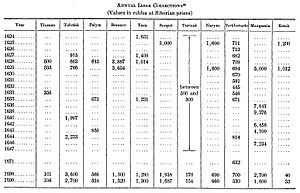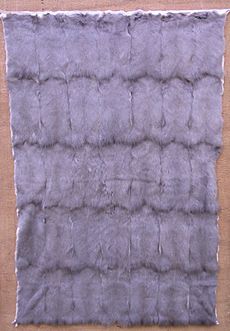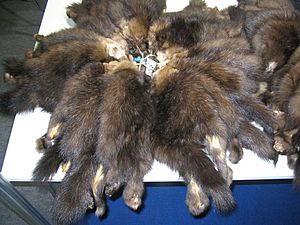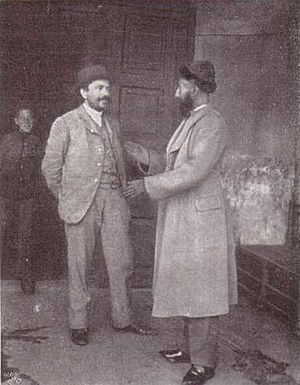Siberian fur trade facts for kids
The Siberian fur trade was all about finding, buying, and selling valuable animal furs from Siberia. This trade grew from small local exchanges to a worldwide business. It greatly shaped how Siberia developed, leading to more exploration and settlements. However, it also caused a big drop in the number of fur-bearing animals and played a role in Russia taking control of Siberia.
Contents
How the Siberian Fur Trade Began
For a long time, people in Siberia hunted animals mainly for food. They only used the fur from these animals for simple things like gloves and hats. But when Russians arrived in Siberia, hunting animals just for their fur became a common practice. The fur from an animal called a Sable quickly became the most valuable and popular type of Siberian fur. It is still highly prized today.
The Siberian fur trade started in the 1500s and was busiest in the 1600s. It continues even now. While sable has always been the most desired fur, many other animal pelts were also traded. These furs were mostly used to make clothing. Some of the best places for furs in Siberia were the Yakutsk, Kamchatka, and Okhotsk areas.
A very rich and powerful Russian family, the Stroganovs, were key players in starting Siberia's fur trade. They owned a lot of land in Siberia and made huge profits by trading with the local people for furs. The Stroganov family helped make fur trading very important for both Russia and Siberia, both economically and culturally.
Getting the Furs
Russians used several ways to get furs from Siberian hunters. These included `yasak` (a fur tax), buying furs, taking them by force, going on hunting trips, and trading with native groups. Much later, they also started raising fur animals on farms. `Yasak` was the easiest way to get furs because it was simply demanded as a tax from the Siberian natives. Russian explorers and hunters were not as good as the Siberians at hunting animals without damaging the fur. This made trading with the Siberians the second easiest way to get good pelts. The Siberian natives knew how to kill animals without ruining their valuable fur.
Yasak: The Fur Tax
`Yasak`, also known as `Iasak`, was a fur tax that Siberian natives had to pay to the Russian government. Russians would set up winter camps while waiting for the Siberians to hunt and pay their fur taxes. In return, the Siberians were promised protection from the Russian government. If a native group or person did not pay the tax or resisted, they could face actions from Russian soldiers.
This tax could be for individuals, a whole tribe, or both. All men between 18 and 50 years old had to pay this tax. The type and amount of fur needed for the tax changed based on how many animals were available. For example, in the early 1600s, the tax might be 5 to 22 sable furs per man. But by the mid-1600s, it dropped to three sable furs because there were fewer sables. In 1601, Russian tax collectors in the Verkhoturye area collected about ten sables a year from every married man and five sables from every single man. Officials also asked for extra furs as "gifts." As sable numbers went down, other furs like fox, squirrel, and ermine were also accepted. For example, one sable fur could be exchanged for one fox, glutton, or otter fur; two blue-fox furs; sixteen polar-fox furs; or one hundred squirrel furs. The Russian government decided how many other furs were equal to one sable fur.
Within 40 years, almost all Siberian natives were forced to pay fur taxes to the Russians. By 1650, Russian traders and explorers had reached the Pacific coast. They were collecting fur taxes from most native groups along the coast.
Hunting and Trading with Natives
Besides the fur tax, Russians got furs mainly by hunting animals themselves or by trading. `Promyshlenniki` was the Russian name for small groups of traders and trappers who worked in the Siberian fur trade. They were free men who made a living by trapping furs. They worked together to set traps, gather food, and build camps in the harsh Siberian weather. These groups would share the furs they caught equally among all members. Working in groups protected them from the cold winters, unexpected attacks, and other dangers. During the busiest time of the fur trade in the 1600s, over a thousand of these trappers and traders went into Siberia each year. Many men were eager to get rich, just like the Stroganovs.
There were two main types of fur traders. Some small groups bravely went into Siberia's wild forests to trade directly with natives. But many more traders stayed in Russia and sent agents to work for them in Siberia. Both independent traders and agents usually stayed in Siberia for two to six years. This depended on how far they traveled, how lucky they were with trading and trapping, and how bad the weather was. The most common items traded were Russian goods like metal tools, iron products, hunting gear, firearms, and food supplies. For most natives, the hunting equipment and metal products were the most useful and desired trade items. In the first few centuries of fur trading, there were no rules or oversight for the traders. Siberian natives often did not know the true value of their furs. Russian traders often took advantage of this. For example, natives might pay for one copper pot with only enough sable furs to fit inside the pot. This was a tiny part of the furs' real worth. Traders sometimes used threats to get more furs. For instance, one report from Okhotsk told of a trader who took children from a local native Tungus group. He then sold them back to their parents for one sable fur each. In some cases, traders held native women and children hostage. This forced fathers, brothers, and husbands to bring furs in exchange for their loved ones' safety.
Fur hunting trips into Siberia usually involved groups of 6 to 60 men. They stayed in small winter huts in the Siberian forests. The groups used fish or meat to bait pit traps for sable. They also tracked other animals with nets and dogs. They would typically spend up to six or seven weeks hunting at a time. When hunting on land, they often used dog teams trained to smell and hunt animals, especially sable. The dogs were trained not to kill the animals. Hunters worried that the dogs would ruin the valuable fur by tearing it. Hunters also sometimes used dogs to retrieve animals after they were killed. Hunters usually killed the animals themselves, trying their best not to damage the pelts.
Hunters used bows, traps, snares, and nets to catch and kill animals for their furs. They would also follow animal footprints to their homes and catch them as they came out. Water animals, like sea otters, were also hunted for their furs. Hunters would balance on small kayaks and throw spears to kill these water animals. This skill was often passed down from father to son and taught at a young age.
Few Russian hunters were as skilled as the Siberian natives at killing animals without damaging the furs. This made trading the better way to get these pelts. Hunting was also dangerous. Hunters faced the risk of illness, accidents, injuries from animals, or fights with the native people of Siberia. Even in the best conditions, hunting and trading groups exploring Siberia only had about seven months after the spring thaw before the Siberian winter forced animals into shelters, stopping hunting for the season. Early routes for fur traders followed the large rivers in Siberia. Furs were easier to transport by water than by land. These rivers connected the main fur collection centers and allowed for relatively fast travel between them. The fur pelts were tied between two boards for transport along these rivers and were called "timbers."
By the 1900s, many valuable fur animals were raised on farms. However, the most valuable furs still came from the wild. This is because farm-raised animals were thought to have less luxurious furs. Wild animal furs are more valuable because the harsh climates forced the animals to naturally grow thick, warm fur. Animals raised on farms do not need to grow such thick fur for protection.
Sable: The Golden Fleece
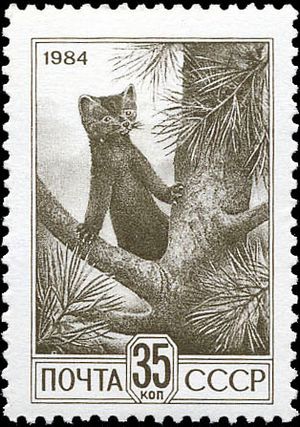
Sables were the first fur animals in Siberia that interested Russians. Sables were called the "Golden Fleece" because they were extremely valuable, both locally and worldwide. A fur store describes sable fur as "almost weightless, silky, satin-like, lustrous, sparkling, glistening, incredibly beautiful. In addition it is very warm and durable."
Sable continues to be the world's most valuable fur. The most desired sable furs come from the Barguzin area of Siberia. The sable is a small animal that looks like a mix between a weasel and a cat. It eats pine nuts, mice, and squirrels and hunts mostly at night. Sable fur is better than other furs because of its silky, thick texture and shiny shades of beige, brown, gold, silver, and black. The darkest shades of sable fur are the most valuable. After sable, Siberian fox and squirrel furs are the next most valued furs from the region.
Besides sable, black and white fox, ermine, beaver, squirrel, lynx, wolf, wolverine, rabbit, marten, walrus, sea otter, and polar bear were also hunted for their furs. Most of these fur animals live in the Siberian taiga (forests). Sea otters and walrus were found on the North Pacific coasts. More recently, fur farming has been used to breed animals for their fur. Silver fox farms started in 1936, mostly in Yakutia. These farms made getting furs safer and more predictable than hunting in the wild.
This trade of valuable fur animals from Siberia greatly impacted the world fur trading industry. In 1910, furs from Siberia made up almost half of the world's furs. This included 70,000 sables, ten times that many ermines, 5 million rabbits, and 15 million squirrels. Today, the most valuable furs still come from Siberia.
Big Profits from Furs
The money made from the Siberian fur trade was huge. Siberian furs were known as "soft gold" because they were as valuable as real gold. In 1992, the Siberian fur industry was worth about $62 million a year.
In the 1500s, a top-quality sable fur could sell for ten times what a peasant family earned in a year. A black fox fur could bring ten times the price of a sable. Private traders sold about 350,000 rubles worth of Siberian furs each year during the 1600s. To compare, a peasant family of four earned less than one ruble a year from a good farm. In 1623, just a few good fox furs could buy 50 acres of land, a decent cabin, five horses, ten cattle, twenty sheep, and still leave money over. In the 1990s, white ermine furs were worth 16 rubles, squirrel furs were worth 5 rubles, and sable furs were worth 150 rubles. These furs were even used as money in the past. Fur-lined cloaks and hats were a special sign of Russian royalty.
At the peak of the fur trade in the mid-1600s, Siberian furs made up more than ten percent of Russia's total income. The Russian government set the price for furs in Siberia. They kept the price low to make a bigger profit when selling furs abroad. All local furs were sold to the state fur company in Irkutsk or Tobolsk, two of Siberia's largest fur trading centers. A first-grade fox fur was sold to the state trading center in Irkutsk for 108 rubles (about $18 in 1990). That same fur was then sold in Anchorage, Alaska, for over $150 (about 4,779 rubles).
Today, fur clothing is still a sign of wealth around the world. The prices for top fur clothing continue to rise. The sable coat, especially, is a symbol of high status and is one of the most desired types of fur coats. There are American and Canadian versions of the sable coat, but the Russian version is the most valuable. Today, a full-length Siberian sable fur coat can cost around $100,000 (about 3,185,850 rubles). They are sold in many major cities worldwide, like Paris, Milan, and New York.
Trading Partners Around the World

Siberian fur quickly became very popular worldwide soon after the trade began in the 1500s. For the first few centuries, most of the Siberian fur trade was controlled by Russian explorers and traders. But trade connections also existed between Siberia and other parts of Europe and Asia. There was a great demand for fur in Byzantium and Western Europe.
Furs were also traded to China and Persia. In return, Siberian fur traders got silks and other luxury goods from those places. These goods were not common in Siberia, so they were in high demand. Furs sold to China were a huge source of income during the 1700s. Furs sold in China for up to ten times more than they would locally. Chinese buyers bought more than 7 million Siberian fur pelts a year. The Chinese preferred squirrel furs because they were warm, durable, and relatively inexpensive. These furs became very popular in Chinese winter clothing.
Trade connections were also made between Siberia and Bukhara, Khiva, and other important trade centers in the Islamic regions of Central Asia. Merchants from Bukhara often came to Siberian towns looking for furs.
As Russians traveled across the Pacific Ocean, North Americans also became part of the fur trade. Siberian furs were brought to Alaska and traded there. This indirectly connected Siberia with the Western Hemisphere and the Americas.
Today, Siberian furs are still very popular in international fur trade. Furs from the northern Siberian tundra are often found in international fur auctions around the world and sell for high prices. The Siberian fur trade has major trade connections in Europe, Asia, and the Americas. Trappers still hunt for fur, and the sable is still the most important fur animal. Many native Siberian people rely completely on trapping for their living.
Benefits of the Fur Trade
The fur trade brought many good things to Siberia, socially, economically, and physically. Fur traders brought new people to Siberia looking for furs. These trappers, traders, and explorers connected with the native people. For example, Russian men who came to Siberia for the fur trade often met and married native women there. Men who settled in Siberia helped the population grow and become more diverse. They brought their Russian culture and skills to Siberia. Siberians also benefited from their furs being the most desired furs in the world. As Siberian fur became popular, Siberia started to be seen as a place full of valuable natural resources, not just an empty land. Finally, the fur trade brought products that were not common in Siberia, such as weapons, metal tools, and exotic silks and spices.
The Siberian fur trade encouraged people to explore and settle the vast Siberian land. Hunters traveled across the tundras, forests, and woods looking for animals. They built camps and forts along the way. This exploration and building helped Siberia develop and become more modern. Russians quickly expanded into Siberia, driven by the promise of getting rich fast from the fur trade. Hunters, trappers, and traders rushed into Siberia in a "Fur Rush." This was similar to the Gold Rushes in California and Alaska in the United States. The growth of several major Siberian cities can be directly linked to the money and profits from the fur trade. The cities of Tobolsk, Tomsk, and Irkutsk became Siberia's main city centers, mostly because of the money brought in by the fur trade.
Siberian fur also became a big part of Russian culture. For example, Soviet Olympic teams wore furs as part of their uniforms at the Olympic games.
Consequences of the Fur Trade
The Siberian fur trade was not entirely good and had several negative effects on Siberia. By the early 1700s, there was a sharp drop in the number of fur-bearing animals across Siberia. Trappers and traders collected furs without thinking about keeping animal populations healthy. Hunters would hunt in an area until most animals were gone, then move to another hunting ground. In 1913, a ban was put on sable hunting to prevent this animal from becoming extinct.
Many animals were killed for the Siberian fur trade, which greatly harmed Siberia's environment. In the mid-1800s, about 10-15 million squirrels were killed in Siberia each year. Tens of thousands of ermines, rabbits, martens, foxes, sables, lynx, and wolverines were also killed. Most of these animals are small, and a single jacket needs many furs. For example, several hundred squirrel furs are needed to make one fur cloak. In Irkutsk, a major fur trade center, more than 150,000 sable furs, thousands of Arctic foxes, and hundreds of thousands of squirrels passed through its customs house each year. Hunters also came to Siberia with the wrong idea that Siberia was an endless wilderness that could not be used up. They hunted and killed without caring about keeping animal populations stable.
Fur Products
Siberian furs have been used to make many different products. Fur clothing is the most common. Clothes made from Siberian fur include coats of different lengths, hats, gloves, shawls, and boots.
The most popular fur item sold worldwide is the fur coat. Siberian fur coats can be mid-length or full-length, reaching the knees or the floor. Fur coats can be made from almost any type of fur. But the most valued furs are soft and flow gently around the body. For example, reindeer fur is not usually used for coats because it can become stiff and hard in the cold.
Siberian sable coats are the most expensive fur clothing. They come in seven different shades. The shade depends on which part of Siberia the fur comes from and what season the sables were hunted. The fur from the sable's head has the darkest color, a dark bluish-black, which is the most expensive type of sable fur. Normal head coloring is blackish-brown to dark blue fur. Most sable fur is light chestnut blue at the roots and yellow-sand at the ends. Barguzinskiy sable coats sell for around $80,000 (about 2,550,280 rubles).
Siberian squirrel coats are also very popular in today's markets. The blue-grey furs are considered the best type of squirrel fur. They are soft and lightweight, but this type of fur is also delicate. Siberian squirrel coats are less expensive than sable coats, but prices depend on quality and color.
Fitch and corsac furs are used for coats. The best quality fitch fur comes from Siberia. The fitch, or European polecat, is an animal like a ferret. The corsac is a type of fox also found in Siberia. However, these furs are less popular because foxes are common in almost every fur-trading country.
The Siberian ushanka is a full fur hat, made entirely of warm fur. It is commonly made from black foxes, red foxes, silver foxes, shadow foxes, blue foxes, brown foxes, raccoons, martens, or black beavers. It covers the top of the head and comes down to cover the ears and back of the head. This is the warmest fur hat available worldwide. Prices depend on the type and quality of fur, but can cost up to $650.00 (about 20,721 rubles).
Fur boots are also popular in cold climates. Reindeer fur boots are popular in Siberia and around the world. Like most of Siberia's fur products, these boots can be very expensive. These boots start at about $330–$400 (about 10,000-12,000 rubles) and can go up to about $630 (about 20,000 rubles). These are a reindeer fur version of the Russian valenki boot. Fur boots can also be made from a variety of different furs. But reindeer is the most popular because it is very good at keeping warm. Other furs, like sable, are considered too luxurious and beautiful to be used for footwear.
Siberian fur gloves can also be made with different furs. The most common types of fur used for gloves are fox fur, raccoon, coyote, and rabbit. These are chosen for their softness and warmth. Prices can range from $59.95 (about 1,911 rubles) to $449.95 (14,344 rubles) depending on the product and how much fur is used.
See also
 In Spanish: Comercio de pieles en Siberia para niños
In Spanish: Comercio de pieles en Siberia para niños




